Introduction
About 90% of Brazilian rice production is obtained by cultivation in irrigated systems, while the rest is produced by rainfed conditions. The productivity of rainfed rice is close to 2,028 kg ha-1. This is considered low and economically unprofitable and has culminated in economically unattractive production, leading to a decrease in this type of cultivation in recent years (Oliveira Neto, 2015). Rainfed production is dependent on rainfall distribution and water deficit during the flowering and grain filling phases and leads to significant reduction in productivity (Oliveira Neto, 2015). A lack of good production practices contributes to an increase in the detrimental effect of drought stress (Oliveira Neto, 2015).
The occurrence of more frequent extreme weather events increases the risk of low yields and creates concerns for the future of crop production and, consequently, for global food security (Wheeler and Von Braum, 2013). This is related to the effects triggered by stress factors, such as prolonged droughts and rising air temperature, that are reflected by a decrease in crop growth and productivity in several regions of the world.
Soil water deficiencies also compromise the vegetative and reproductive development of rice plants (Terra et al., 2015). Damage associated with soil water deficits is caused by the onset of a series of morphological and physiological changes, such as a decrease in the relative intracellular water content, leading to lower photosynthetic capacity and gas exchange reductions and culminating in lower amounts of energetic reserves used for the formation of tissues in different developmental stages (Awasthi et al., 2014; Zhou et al., 2017).
Initial plant establishment is relevant to the next stages of vegetative and productive development (Batista et al., 2015). The occurrence of adequate internal moisture contents in seed germination is essential for optimum development of the seedling, since water is the main factor involved in germination (Taiz et al., 2017). During stages I and II of hydration, the distribution and translocation of nutrient reserves present in the composition of the endosperm takes place, which will nourish the embryo and the seedling until it becomes autotrophic (Franco et al., 1997; Taiz et al., 2017). For this reason, Franzin et al. (2007) observes that upland rice seeds immersed in water for periods of 16 h to 24 h increases their capacity for normal plant formation with a greater developmental capacity.
In addition to the technique of soaking seeds in water, the introduction of vitamins into the solutions has potential agricultural use, especially cases of stressful plant developmental factors. This fact was demonstrated by using niacin and thiamine solutions for soaking corn seeds, in order to alleviate the deleterious effects caused by saline stress during the germination and initial developmental stages of plants (Hassanein et al., 2009; Kaya et al., 2014). In these studies, the authors observe positive responses up to the highest concentrations of 100 mg L-1 for both vitamins.
Despite the benefits of introducing vitamins into plant production, research on these compounds is still scarce and application techniques have not been established. Thus, we propose new research that exposes new methodologies of vitamin use in different species of economic interest, in which possible benefits or damages from the application of these substances can be demonstrated in the face of abiotic stress factors of the productive system.
From seed germination to grain production, a rice crop needs 450-700 mm of water (Rodrigues et al., 2004). This amount of water can be optimized with the application of good practices, such as the previous immersion of seeds in biostimulants. The objective of this research was to evaluate the influence of rice seed immersion in a niacin solution on plant development, including influences on the plant's physiological status and production.
Materials and methods
This research was conducted in an experimental zone located in the city of Goiânia, in the central region of Brazil (16°40'S, 49°15'W and 750 m a.s.l.). The region has an Aw climate in the KÖPPEN-GEIGER classification (Cardoso et al., 2014) and is characterized by a tropical climate with a rainy season from October to April and a dry period with less than 100 mm of monthly rainfall from May to September. Mean monthly temperature varies from 20.8°C in June and July to 25.3°C in October (Cardoso et al., 2014).
We calculated the water balance extract, potential and crop evapotranspiration (Fig. 1A) with the methodology of Rolim et al. (1998), and we used different Kc values in the different crop developmental periods according to Arf et al. (2012). We obtained temperature, relative humidity, and precipitation during the study through data gathered from a meteorological station located 100 m from the experimental area (Fig. 1B).
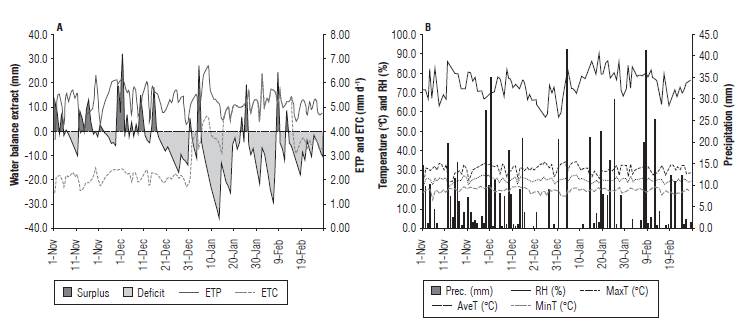
FIGURE 1 Water balance, potential evapotranspiration (ETP), crop evapotranspiration (ETC) (A), precipitation (Prec.), relative air humidity (RH), maximum (MaxT), average (AveT), and minimum (MinT) temperature (B) during the experiment.
Soil at the experimental area was classified as a LATOS-SOLO VERMELHO (Santos et al, 2013) with the following characteristics: Ca2+: 4.30 cmolc dm-3, Mg2+: 1.80 cmolc dm-3, K+: 170.00 mg dm-3, P (Mehlich I): 47.00 mg dm-3, organic matter: 16.00 g dm-3, Al3+: 0.0 cmolc dm-3, H+Al: 4.00 cmolc dm-3, pH (CaCl2): 5.40, CEC: 10.53 cmolc dm-3, V: 62.00% (Donagemma et al., 2011). The granulometric analysis of the soil showed 4800 g kg-1 of clay in the 0-0.20 m layer (Silva, 2009).
The experiment was carried out in randomized blocks, with a 2x4 factorial scheme. The treatments were defined by a combination of two seed soaking times (12 and 24 h) at four concentrations (0, 100, 200 and 300 mg L-1) of niacin solutions (100% a.i. nicotinic acid) distributed in five replicates. Each experimental plot had an area of 0.20 x 0.20 m in high blue density polyethylene recipients with a capacity of 140 L and dimensions 0.21 m x 0.51 m x 2.16 m.
We applied the treatments by soaking seeds of upland rice (cv. BRS Primavera) in 100 ml solutions containing the niacin concentrations during the pre-established periods. For the control, the seeds were immersed in distilled water for the same pre-established periods. After soaking, we removed the seeds with a plastic sieve and placed them for drying on paper towels for 30 min in a shaded environment at environmental air temperature.
Sowing in the plots occurred on October 28, 2016, when we arranged twenty seeds in two lines, at a depth of 3 cm. There were no pest occurrences or pests requiring chemical control. We carried out single cover fertilization in stage V4 when we applied nitrogen using urea (46%) at a dose equivalent to 40 kg ha-1. We irrigated daily up to 10 d after planting, and after this period watering occurred naturally from rains. We used natural water restriction to create a stress environment.
We performed daily counting of seedlings from the fourth day after sowing, to obtain seedling emergence rates (Eq. 1), mean emergency times (Eq. 2) (Labouriau, 1983) and the emergency speed index (Eq. 3) (Maguire, 1962), using the following equations:
where:
EME: seedling emergence (%).
E: total emerged seedlings.
S: total seeds sown.
where:
AET: average emergence time (days).
E1, E2, and En: number of emerged seedlings on the first, second and last count.
T1, T2, and Tn: first, second and last day of evaluation.
N: number of emerged seedlings during the test.
where:
ESI: emergence speed index.
E1, E2, and En: number of emerged seedlings on the first, second and last count.
T1, T2, and Tn: first, second and last day of evaluation.
We performed the first evaluation of the vegetative development when the plants were in the V4 stage. We selected three plants per plot to obtain height, number of tillers, number of leaves, and fresh and dry weight of the shoots. To obtain the dry weight of the shoots, we conditioned the plants in paper bags, followed by drying in a forced air circulation oven (SL-102/336, Solab, Piracicaba, SP, Brazil) (65°C) until we obtained a constant weight.
After the first evaluation, we removed excess plants so that only three plants per plot remained until harvest time, 100 d after sowing. On harvest day we measured the relative indices of chlorophyll a, b and total chlorophyll with a portable chlorophyll meter (CFL1030; Falker, Porto Alegre, RS, Brazil) as well as the biometric characteristics of height and dry plant weight. By obtaining the number of tillers and panicles, we estimated the values of these characteristics for an area of 1 m2. Finally, we obtained the number of spikelets per panicle, fertility of the spikelets and the weight of 1000 grains.
We subjected the data for soaking times to an analysis of variance (test F) and when significant we used the Tukey test at 5% of probability (P<0.05). For the data related to the niacin concentrations, we used a polynomial regression analysis, adopting the significant regression of a greater degree.
Results and discussion
We observed three periods of marked water deficit between the intervals from December 17 to 30, January 05 to 13, and January 29 to February 06, when precipitations of13.8 mm, 0.8 mm and 4.0 mm occurred (Fig. 1). During these periods we observed the morphological response of leaf wilting.
We observed no interaction between the two studied factors (soaking time and niacin concentration). However, we did observe different responses in plant characteristics according to the treatments applied.
During the emergence of the rice seedlings, we observed that only the emergence speed was affected by the soaking periods, regardless of the niacin concentrations (Tab. 1). The average time of emergence was lower when the seeds were submerged for a period of 24 h. We observed an inverse behavior for the emergence speed index; it was higher for submerged seeds during this same period. Thus, seed immersion for a 24 h period, regardless of niacin concentrations, decreased the average emergence time by 3.70% and increased the emergence speed index by 13.38%.
TABLE 1 Mean values of characteristics related to the emergence of rice plants subjected to different seed soaking times and concentrations of niacin.
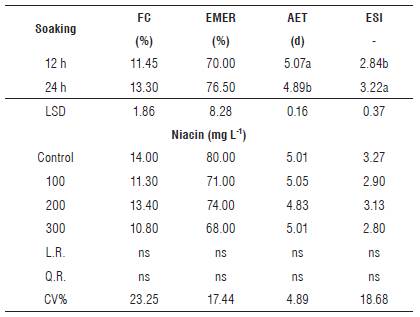
Common letters in a column indicate means are not significantly different at P<0.05 according to the Tukey test. FC: First Count; EMER: Emergence Index; AET: Average Emergence Time; ESI: Emergence Speed Index; L.R.: Linear Regression; Q.R.: Quadratic Regression; LSD: Least Significant Difference; CV: Coefficient of Variation.
The variable factors of immersion time and niacin concentrations did not affect biometric characteristics during theinitial development of the rice plants (Tab. 2). The results may be associated with good moisture conditions in the early stages of development, since we irrigated daily until 10 d after sowing; and after that period there were daily rains with a total of 244.10 mm.
TABLE 2 Mean values of biometric characteristics of rice plants in V4 stage subjected to different seed soaking times and concentrations of niacin.
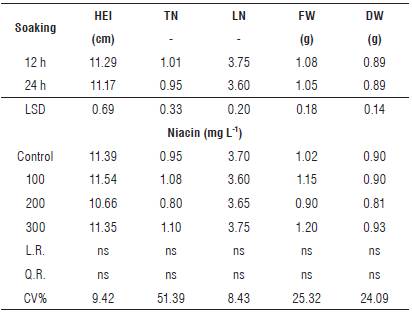
HEI: Height; TN: Tiller Number; LN: Leaf Number; FW: Fresh Weight; DW: Dry Weight; L.R.: Linear Regression; Q.R.: Quadratic Regression; LSD: Least Significant Difference; CV: Coefficient of Variation.
The good soil chemical conditions observed through laboratory analysis, in which high levels of P, K, and organic matter were found, were sufficient for the plants for proper development up to the V4 stage. In a study carried out to verify the responses of different upland rice cultivars to nitrogen fertilization, Cancellier et al. (2011) verifies that the cultivar used in the present study is responsive to low levels of nitrogen in the soil.
During the final evaluation, we observed that the applied treatments did not significantly influence the biometric characteristics of height and dry mass of the plants. The averages obtained for these variables were 11.23 cm and 0.89 g, respectively, and these averages were lower than those obtained in different studies with upland rice, cv. Spring (Cancellier et al., 2011; Terra et al, 2015).
Water stress due to lack of water affects the vegetative development of upland rice plants (Terra et al., 2015). The partial suppression of water supply to plants can trigger a series of morphological and physiological changes. Plants subjected to this type of stress show a decrease in relative intracellular water contents resulting in a decrease in photosynthetic capacity and gas exchange. Consequently, plants have smaller amounts of energy reserves and inadequate vegetative and reproductive development (Awasthi et al., 2014; Zhou et al, 2017).
For the relative indices of chlorophyll a, b, and total chlorophyll, we observed that immersion of the seeds for a period of12 h, regardless of the concentration of niacin, provided values of 16.57%, 15.49% and 16.39% higher than plants from seeds submerged for 24 h (Tab. 3).
TABLE 3 Mean values of the characteristics of rice plants subjected to different seed soaking times.
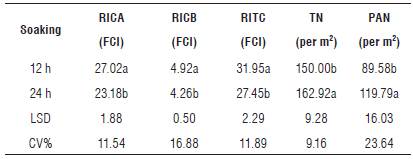
Common letters in a column indicate means are not significantly different at P<0.05 according to the Tukey test. RICA: Relative Index of Chlorophyll a; RICB: Relative Index of Chlorophyll b; RITC: Relative Index of Total Chlorophyll; TN: Tiller Number; PAN: Panicle Number; FCI: Falker Chlorophyll Index; LSD: Least Significant Difference; CV: Coefficient of Variation.
However, for the number of tillers and the number of panicles per m2, seeds soaked for a period of 24 h increased these characteristics to 8.61% and 33.72% respectively, compared to the plants obtained from 12 h of soaking (Tab. 3). According to Franzin et al. (2007), the immersion of upland rice seeds in water for periods of 16 to 24 h can significantly increase the formation of normal and more highly developed plants. This is due to the favoring of complementation between stages I and II of hydration, required for the distribution and translocation of nutrient reserves present in the endosperm of the embryo (Franco et al., 1997). Initial establishment of plants is important, since malformed plants will have difficulties during their development, especially in environments affected by stress factors.
The relative indices of chlorophyll a and total chlorophyll were affected by niacin concentrations (Fig. 2). We observed the increase of these contents up to the maximum concentrations of 208.00 and 205.91 mg L-1, with FCI indices of 26.79 and 31.67, respectively. At that point, the increase reached 21.24% and 20.72% of the relative indices of chlorophyll a and total chlorophyll, compared to the control treatment.
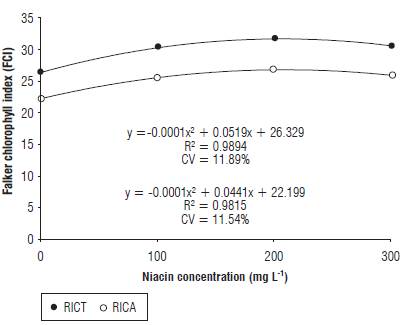
FIGURE 2 Relative chlorophyll a (RICA) and total (RICT) index in rice plants subjected to different concentrations of niacin by soaking seeds.
The results are connected to the exogenous application of niacin, which can favor plant development in environments under the influence of abiotic factors. This can be due to the fact that this vitamin has interactions with plant hormones, acting as a factor in enzymatic activation and participating in the composition of elements of the photosystem, such as NADP, used in atmospheric carbon fixation (Oertli, 1987; Hassanein et al., 2009; Taiz et al., 2017). The use of this vitamin may culminate in an increase of energetic and nutritional reserves and also contributes to vegetative and productive developmental characteristics, as in the case of wheat plants (El-Bassiouny et al, 2014).
We also observed the effect of niacin for the productive elements of upland rice, in which the increase of niacin concentrations increased the number of spikelets per panicle as well as the fertility of the spikelets (Fig. 3), up to maximum values of 129.00 grains and 86.95% of spikelet fertility, obtained with the concentrations of 194.03 and 172.57 mg L-1, respectively. The increase in relation to the control treatment was 41.37% of grains per panicle and 7.49% of fertile spikelets.
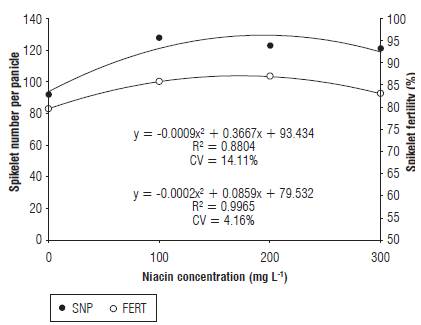
FIGURE 3 Spikelet number (SNP) and fertility (FERT) per panicle in rice plants subjected to different concentrations of niacin by soaking seeds.
We found that increasing concentrations of niacin provided linear and positive responses on the weight of 1000 grains (Fig. 4). Thus, in the highest concentrations used during the study, we obtained with 300 mg L-1 an increase of 4.24 g/1000 grains or 24.58% compared to the control treatment, with rice seed immersion in water. The results might be caused by hormonal action, since the application of niacin stimulates an increase in the amounts of these compounds in the plant tissues (Hassanein et al., 2009; El-Bassiouny et al., 2014). The hormones have the capacity to mobilize different nutrients that can be used in the formation of new tissues of rice plants, besides contributing to normal functioning of the photosynthetic mechanism and the synthesis of proteins (Taiz et al, 2017).
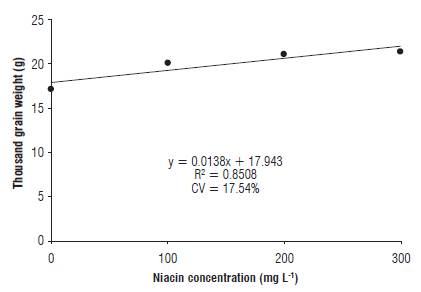
FIGURE 4 Weight of 1000 grains of rice plants subjected to different concentrations niacin by soaking seeds.
We obtained similar results in studies with fava beans (Abdelhamid et al., 2013) and quinoa (Abdallah et al., 2016), where we obtained productive increments by increasing concentrations of niacin up to 400 and 100 mg L-1, respectively, mainly in plants under the influence of abiotic stresses. These results demonstrate that, besides the use of niacin as a potential tool to combat the effects of abiotic stresses, the species factor and the form of application should be taken into account. Thus, we recommend further studies in order to obtain specific information to different growing conditions.
Conclusions
Soaking rice seeds for 24 h, regardless of the concentration of niacin, increases the speed of emergence of seedlings and the number of tillers and panicles per area. However, it decreases the relative indices of chlorophyll in leaves.
The use of niacin promotes gains in the number of spikelets per panicle, fertility of the spikelets and the weight of 1000 grains, besides increasing the relative index of chlorophyll in the leaves of the rice plants.

















